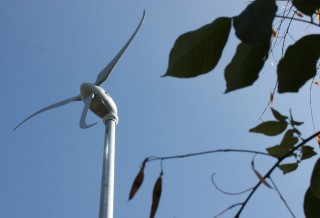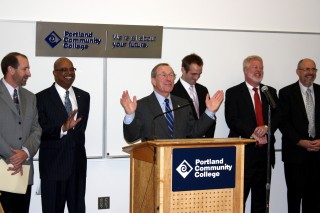This content was published: December 21, 2009. Phone numbers, email addresses, and other information may have changed.
Gov. announces $1 million for PCC’s Net Zero plan
Photos and story by James Hill
In October, Gov. Ted Kulongoski announced that the State Energy Program is awarding a $1 million grant to Portland Community College’s Net Zero energy efficiency plan for its Sylvania Campus (12000 S.W. 49th Ave.).

PCC's new wind turbine at the Sylvania Campus will help renewable energy technician students practice their skills.
As part of the first phase of PCC’s Net Zero project (producing as much energy as it requires on-site), the State Energy Program funds would go toward the cost of identified improvements at the 47-year-old College Center Building on campus. The total cost of the project is $15.4 million with PCC contributing $9.7 million of its own money to get the work done. The project also will create 228 jobs during its time span as workers complete each phase of the green overhaul.
“This award represents the first phase of PCC’s Net Zero initiative as it begins to develop a self-sufficient campus where carbon emissions are eliminated and all energy needs are met with renewable energy generated on-site” said Gov. Kulongoski. “These dollars will allow the college to move forward with this ambitious vision and provide a national model for sustainability.”
PCC’s District President Preston Pulliams, Campus President Linda Gerber and a cadre of stakeholders including staff, faculty and students were overjoyed at the news.
“As the largest post-secondary institution in the state, it makes sense for us to be engaged in this work,” said Pulliams. “Our board of directors, our students and our faculty are all passionate believers in sustainability. PCC is quickly developing a comprehensive array of green technology programs and options that will prepare students to work in the green economy.”
The energy efficiency measures for the 178-thousand-square-foot CC Building include: Repairing fresh air ductwork to allow outside air free-cooling; Sealing up leaks in the ductwork to keep from losing conditioned air to the outside; installing high efficiency electric motors; adding speed drives to provide accurate and efficient system control; connecting additional parts of the building to the more-efficient central cooling system; redesign the server room so that cool air is directed to the equipment that needs it most; installing more air filter systems that will do a better job while consuming less energy; and program the building HVAC controls so that they work together and efficiently.
“This federal investment provides an unprecedented opportunity to make significant improvements in energy efficiency and renewable energy projects for public buildings throughout the state, creating both jobs and energy savings for Oregonians,” said Gov. Kulongoski. “These projects will increase energy efficiency, use renewable sources of energy, incorporate promising technologies, conserve resources, reduce energy costs, and most importantly invest in local economies.”

Gov. Ted Kulongoski makes the grant announcement to PCC’s Net Zero plan. Behind him, left to right, are Oregon Department of Energy Director Mark Long, PCC President Preston Pulliams, President of Gerding Edlen Sustainable Solutions Kipp Baratoff, Chair of Oregon Way Advisory Group Wally Van Valkenburg, and the Director of the Department of Environmental Quality Dick Peterson.
The announcement was part of more than $7.25 million in American Recovery and Reinvestment Act (Recovery Act) awards for 97 energy efficiency and conservation projects across the state. Combined with matching and other leveraged funds, these Oregon public building projects total nearly $46.2 million in energy investments, creating about 139,662 worker hours and delivering thousands of dollars in energy savings.
The Recovery Act funds being awarded through the State Energy Program can be used for public buildings, including K-12 schools, colleges, universities, and government buildings. The U.S. Department of Energy administers the funds, approves the projects and reviews the state’s progress.
“Conservation projects like these help us provide Oregonians with affordable, reliable energy today and into the future,” said Oregon Department of Energy Director Mark Long.
The Net Zero initiative is just part of a long time effort by the college to develop sustainable practices. In 2006, the PCC Board of Directors developed a sustainable use policy that was followed by President Pulliams signing the American and University Presidents Climate Commitment. This last summer the college released its Climate Action Plan underlying PCC’s commitment to reduce carbon emissions. All of these initiatives dove tail into the college’s green technology programs – Renewable Energy Technician, Electronic Engineering Technology, Microelectronics Program’s partnering with SolarWorld, Building Construction Technology, Interior Design, and many more.
“In the decade between 1965 and 1975 a new community college opened its door every two weeks across this nation,” Pulliams said. “This project will be a model for those aging campuses on how to convert and address some of these critical climate change issues.”
